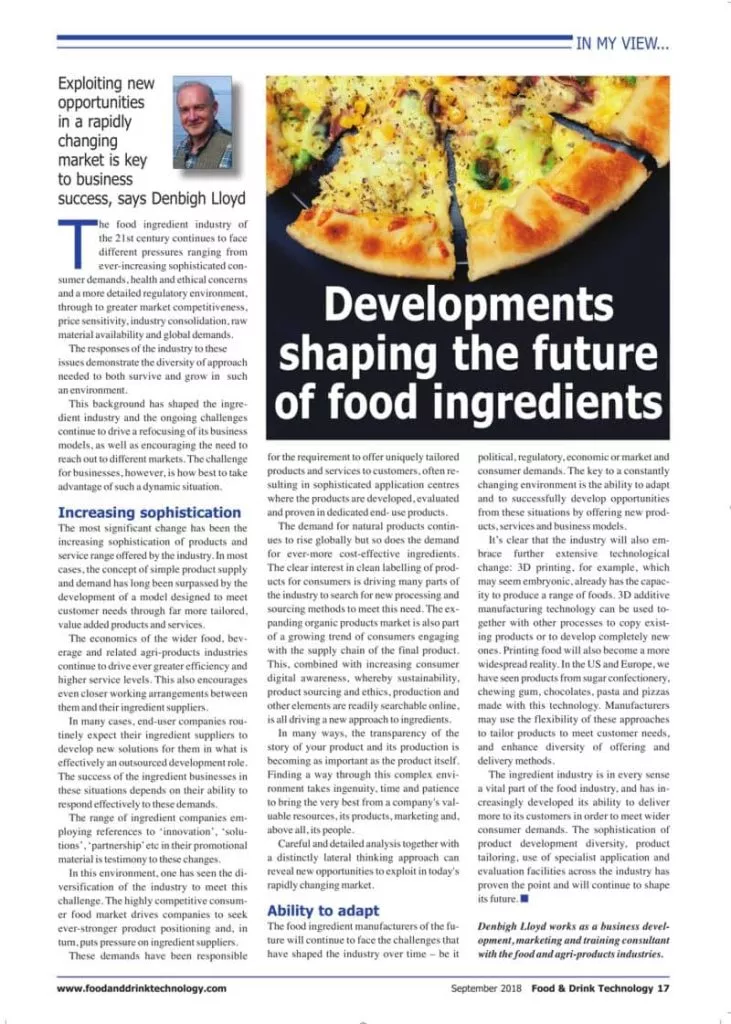Transcript of the article in Food & Drink Technology September 2018.
IN MY VIEW…
Exploiting new opportunities in a rapidly changing market is key to business success, says Denbigh Lloyd
The food ingredient industry of the 21st century continues to face different pressures ranging from ever-increasing sophisticated consumer demands, health and ethical concerns and a more detailed regulatory environment, through to greater market competitiveness, price sensitivity, industry consolidation, raw material availability and global demands.
The responses of the industry to these issues demonstrate the diversity of approach needed to both survive and grow in such an environment.
This background has shaped the ingredient industry and the ongoing challenges continue to drive a refocusing of its business models, as well as encouraging the need to reach out to different markets. The challenge for businesses, however, is how best to take advantage of such a dynamic situation.
Increasing sophistication
The most significant change has been the increasing sophistication of products and service range offered by the industry. In most cases, the concept of simple product supply and demand has long been surpassed by the development of a model designed to meet customer needs through far more tailored, value added products and services.
The economics of the wider food, beverage and related agri-products industries continue to drive ever greater efficiency and higher service levels. This also encourages even closer working arrangements between them and their ingredient suppliers.
In many cases, end-user companies routinely expect their ingredient suppliers to develop new solutions for them in what is effectively an outsourced development role. The success of the ingredient businesses in these situations depends on their ability to respond effectively to these demands.
The range of ingredient companies employing references to ‘innovation’, ‘solutions’, ‘partnership’ etc in their promotional material is testimony to these changes.
In this environment, one has seen the diversification of the industry to meet this challenge. The highly competitive consumer food market drives companies to seek ever-stronger product positioning and, in turn, puts pressure on ingredient suppliers.
These demands have been responsible for the requirement to offer uniquely tailored products and services to customers, often resulting in sophisticated application centres where the products are developed, evaluated and proven in dedicated end-use products.
The demand for natural products continues to rise globally but so does the demand for ever-more cost-effective ingredients. The clear interest in clean labelling of products for consumers is driving many parts of the industry to search for new processing and sourcing methods to meet this need. The expanding organic products market is also part of a growing trend of consumers engaging with the supply chain of the final product. This, combined with increasing consumer digital awareness, whereby sustainability, product sourcing and ethics, production and other elements are readily searchable online, is all driving a new approach to ingredients.
In many ways, the transparency of the story of your product and its production is becoming as important as the product itself. Finding a way through this complex environment takes ingenuity, time and patience to bring the very best from a company’s valuable resources, its products, marketing and, above all, its people. Careful and detailed analysis together with a distinctly lateral thinking approach can reveal new opportunities to exploit in today’s rapidly changing market.
Ability to adapt
The food ingredient manufacturers of the future will continue to face the challenges that have shaped the industry over time – be it political, regulatory, economic or market and consumer demands. The key to a constantly changing environment is the ability to adapt and to successfully develop opportunities from these situations by offering new products, services and business models.
It’s clear that the industry will also embrace further extensive technological change: 3D printing, for example, which may seem embryonic, already has the capacity to produce a range of foods. 3D additive manufacturing technology can be used together with other processes to copy existing products or to develop completely new ones. Printing food will also become a more widespread reality. In the US and Europe, we have seen products from sugar confectionery, chewing gum, chocolates, pasta and pizzas made with this technology. Manufacturers may use the flexibility of these approaches to tailor products to meet customer needs, and enhance diversity of offering and delivery methods.
The ingredient industry is in every sense a vital part of the food industry, and has increasingly developed its ability to deliver more to its customers in order to meet wider consumer demands. The sophistication of product development diversity, product tailoring, use of specialist application and evaluation facilities across the industry has proven the point and will continue to shape its future.
Denbigh Lloyd works as a business development, marketing and training consultant with the food and agri-products industries.
September 2018
Food & Drink Technology p17



